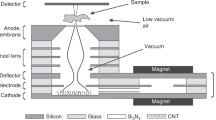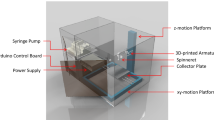Abstract
THE performance of electron guns used in the electron microscope has been studied by Haine and Einstein1, Boersch and Born2, and others. The present indications are that pointed filaments improve this performance. The first of these filaments was prepared by Hibi3 by hand-polishing or etching a short length of tungsten wire which was welded or otherwise attached to a conventional hairpin filament according to Müller's method4. Heating was obtained by conduction from the hairpin.
This is a preview of subscription content, access via your institution
Access options
Subscribe to this journal
Receive 51 print issues and online access
$199.00 per year
only $3.90 per issue
Buy this article
- Purchase on Springer Link
- Instant access to full article PDF
Prices may be subject to local taxes which are calculated during checkout
Similar content being viewed by others
References
Haine, M. E., and Einstein, P. A., Brit. J. App. Phys., 3, 40 (1952).
Boersch, H., and Born, G., Proc. Fourth Intern. Conf. Electron Microscopy, Berlin, 1958, 35.
Hibi, T., Proc Intern. Conf. Electron Microscopy, London, 1954, 636.
Müller, E. W., Z. Phys., 106, 541 (1937).
Swift, D. W., and Nixon, W. C., Proc. Second European Regional Conf. Electron Microscopy, Delft, 1960 (in the press).
Author information
Authors and Affiliations
Rights and permissions
About this article
Cite this article
BRADLEY, D. Simple Methods for preparing Pointed Filaments for the Electron Microscope. Nature 189, 298–300 (1961). https://doi.org/10.1038/189298c0
Issue Date:
DOI: https://doi.org/10.1038/189298c0
Comments
By submitting a comment you agree to abide by our Terms and Community Guidelines. If you find something abusive or that does not comply with our terms or guidelines please flag it as inappropriate.



